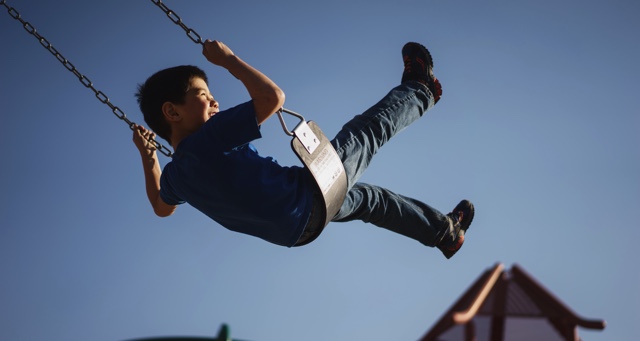Kids are more perceptive than many adults give them credit for, and they know when there’s something big going on in the lives of people around them, be it something good or something not so good. Sometimes, however, it’s hard to know how to talk to kids about subjects like anxiety or cancer or friendship; it’s not that they don’t understand the concepts (they probably understand them better than most adults do), but an adult, lived-in frame of reference doesn’t translate to the experiences the majority of kids have had.
Thankfully, stories exist that put these issues into words and pictures that do work with kids’ experiences. That doesn’t mean trusted adults are off the hook: this process works best as a partnership in which kids and adults read together and adults are available to answer questions.
Here (in no particular order) are five graphic novels that do a fantastic job tackling tough issues.
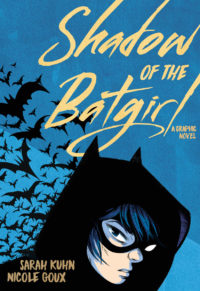 Shadow of the Batgirl by Sarah Kuhn and Nicole Goux (DC Graphic Novels for Young Adults, 2/4/20)
Shadow of the Batgirl by Sarah Kuhn and Nicole Goux (DC Graphic Novels for Young Adults, 2/4/20)
In fairness, there aren’t many children born to assassins who program them to be killers from the age of 8. Kids do, however, have abusive parents who isolate them, deprive them of the vital tools necessary for human communication, drive them to the desperate solution of running away. Like Cassandra Cain in Shadow of the Batgirl, those children face starvation and homelessness. If they’re lucky and find folx willing to take them in, take care of them, help them learn, they may struggle with how to behave or even act out, which children who have never experienced that sort of anxiety may not understand or may find frightening. Understanding how hard it is to fit when you’ve lived your entire life alone will make kids more empathetic with those from different backgrounds and those who have been deliberately cast as outsiders.
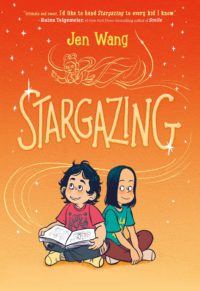 Stargazing by Jen Wang (First Second)
Stargazing by Jen Wang (First Second)
Jen Wang’s second graphic novel is very, very different from The Prince and the Dressmaker. In it, Christine’s family helps some neighbors in financial difficulty by renting them the in-law house on their property. Christine is wary of Moon, a girl her own age moving into the house with her mother, who she’s heard likes to beat people up.
After a rough start, Christine and Moon become the best of friends, even if Christine doesn’t totally understand what Moon is talking about when she says she should actually be living with celestial friends among the stars. Because of Moon, Christine starts to try new things like painting her toenails and listening to K-Pop, so it’s hard not to get jealous when Moon starts to share those things with Madison as well. When Moon is diagnosed with a serious illness, however, and has to go into the hospital for surgery, Christine thinks it’s her fault because of a mean prank she played while she was mad, and she isn’t sure how to fix the mess she thinks she made.
Friendships, cancer, and guilt are all hard to explain abstractly, but in Stargazing children can see kids their own ages working through these issues and the thought processes those kids use parse the hardest bits. Wang’s narrative is also a great example of a fight not necessarily being the end of a relationship but a step in two people understanding one another more thoroughly.
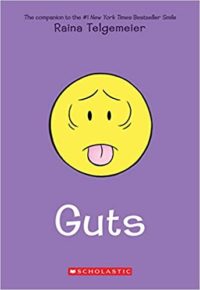 Guts by Raina Telgemeier (Scholastic Graphix)
Guts by Raina Telgemeier (Scholastic Graphix)
One of Telemeier’s autobiographical graphic novels, Guts takes on a topic that affects a lot of kids: anxiety. Many of those kids (my own daughter included) and even some adults find their anxiety manifests in physical ways, especially stomach aches. Add to that the stigma still attached to open discussion of mental health topics and and going to a therapy, and things seem even worse (at least initially).
Telgemier’s honesty in this book is an important thing for kids (and their adults) to see. It makes anxiety into feelings rather than pathology and therapy into something that can help rather than something else to be feared. It also models the concept of telling your story, even if it’s difficult, because hearing that story may be the first step in someone else reaching out for the help they need.
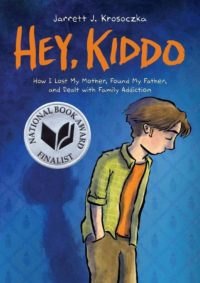 Hey, Kiddo by Jared Krosoczka (Scholastic Graphix)
Hey, Kiddo by Jared Krosoczka (Scholastic Graphix)
This is a heavy book. It’s also an important one. Another graphic autobiography, Krosoczka opens up about his childhood, including his mother’s drug addiction; his absentee father; and being raised by his grandparents, who did the best they could but who had thought themselves past the childrearing stage. He talks about his mother’s talent as an artist never being fully expressed due to being in and out of jail and in and out of treatment, and how painful it was when she would appear only to disappear again days or weeks later. He talks about meeting his father and his father’s wife and children, how thrilled he was to have half-siblings and how difficult to know his father had wanted a family but not one that included him.
Kids live in all sorts of families, and it’s important for those in the more traditional sort to understand how different things may be for their friends and, sometimes, how difficult. It’s important for them to learn how to listen when a peer needs an ear, to understand why a classmate may have difficulty following rules or being kind. It’s important for them to learn not only sympathy but empathy, to understand that simply because someone looks like you or goes to the same school or wears the same clothes doesn’t mean their life is anything like yours.
Krosoczka’s work also reminds kids that overcoming the challenges they face is 100% possible with a little care, a little love, and a little faith from someone else.
 Avatar the Last Airbender: The Promise (Dark Horse) by Bryan Konietzko, Michale Dante DiMartino, Gene Luen Yang, and Gurihiru
Avatar the Last Airbender: The Promise (Dark Horse) by Bryan Konietzko, Michale Dante DiMartino, Gene Luen Yang, and Gurihiru
The A:TLA animated series ended without ever really coming to a close. Luckily the story has continued in a series of comic books and graphic novels, my favorite of which are written by Gene Luen Yang and illustrated by Gurihiru.
In The Promise, our young heroes have started to take their places in the world: Zuko is the Fire Lord, Aang has accepted the greater responsibilities of the Avatar, and the others have started to make their own spaces, some with Zuko and Aang and some on their own.
Zuko and Aang aren’t the children they were when they started their adventures, and they’ve both been through hell, but they’re still young and though they understand, intellectually, what they’re supposed to be doing, understand right and wrong, the truth of exactly how they balance those duties with friendships that have become sacred is another matter entirely. As much as they love each other, Zuko and Aang don’t always see eye to eye and in The Promise, their disagreement could spark another war.
Compromise is hard. It’s hard for everyone. There are times compromising is the right call and times where you plant yourself like a tree and say, “No, you move.” Which is all well and good when the other person is a colleague or a stranger. But what do you do when it’s a friend? A friend you’ve fought with, a friend you were willing to die for? Our kids are unlikely to experience anything so extreme as that last but there are times they’ll find themselves ideologically at odds with their friends. How do you teach them when to make peace and when to fight for what you believe in? Those are highly abstract concepts, albeit important ones. Having characters your kids recognize and identify with, characters they may, if they’re anything like my kids, have pretended to be, will serve as a solid bridge to exploring those questions and helping them decide on which answers are the right ones for them.
It isn’t all capes and tights, folx. And even when it is, there’s still something to be learned from comics and graphic novels. If you needs some tools in your tool box, throw a few of the others stuff; your bag may be heavier, but you’ll be glad you did.
By signing up you agree to our Terms of Service
